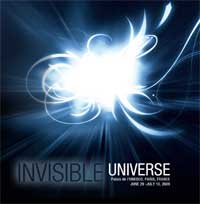International Year of Astronomy at UNESCO: Three scientific events about the invisible universe

- © All rights reserved
Most of the universe is invisible to human eyes and to our most advanced observation devices. What is dark matter and what is dark energy? Our understanding of the physical world will be revolutionized the day we discover the answers to these two questions, which will be central to the “Invisible Universe” programme presented at UNESCO from 29 June to 10 July, as part of the International Year of Astronomy celebration.
“Invisible Universe” is a set of three scientific events: an exhibition, a specialists’ symposium (in English) and a public symposium (in French).
The exhibition “Exploring the Invisible Universe” will show how modern astronomy and more generally modern science has converged toward a vision of our reality based on the invisible, in the sense of not directly detectable. Open from 29 June to 10 July, it will present the history of astronomy and physics as well as important philosophical ideas and works of art that have shaped the cultural landscape of the past four centuries.
The international research colloquium entitled “Dark Side of the Universe: Toward a New Cosmological Paradigm” (Monday 29 June to Friday 3 July) will bring together the top international specialists on dark matter and dark energy, including George F. Smoot and David J. Gross, Nobel laureates in physics, and Alain Connes, Fields Medal winner.
The symposium "L'Univers Outre Noir: Energie Noire et Matière Sombre" (Monday 6 July to Friday 10 July) is open to the public. It will gather outstanding French-speaking scientists who will explain the evolution of knowledge about the universe. Subjects include Saga des trous noirs (Jérome Perez), Ondes gravitationnelles, messagers de l’invisible (Eric Gourgoulhon) and Les paradoxes de l’invisible (Jean Audouze).
Also for the International Year of Astronomy, UNESCO is partnering the exhibition "Cosmos: A journey to the ends of the universe” at the Palais de la Découverte in Paris, France, from 23 June to 22 November. A frieze showing structures in the universe according to their distance from the sun enables the visitor to understand the different objects and their scale, from smallest (solar system, stars, galaxies) to largest (galaxy clusters, filaments).
- Author(s):UNESCOPRESS
- Source:Media advisory No.2009-37
- 22-06-2009

